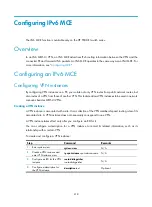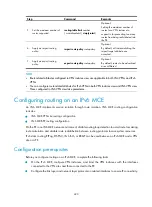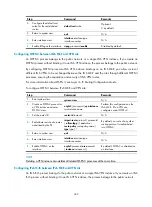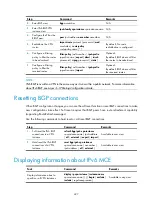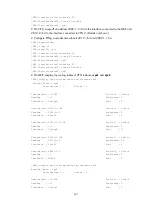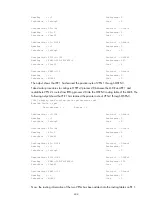
420
Step Command
Remarks
5.
Set the maximum number of
routes supported.
routing-table
limit
number
{
warn-threshold
|
simply-alert
}
Optional.
Setting the maximum number of
routes for a VPN instance to
support is for preventing too many
routes from being redistributed into
the PE.
6.
Apply an import routing
policy.
import route-policy
route-policy
Optional.
By default, all routes matching the
import target attribute are
accepted.
7.
Apply an export routing
policy.
export route-policy
route-policy
Optional.
By default, routes to be advertised
are not filtered.
NOTE:
•
Route related attributes configured in VPN instance view are applicable to both IPv4 VPNs and IPv6
VPNs.
•
You can configure route related attributes for IPv6 VPNs in both VPN instance view and IPv6 VPN view.
Those configured in IPv6 VPN view take precedence.
Configuring routing on an IPv6 MCE
An IPv6 MCE implements service isolation through route isolation. IPv6 MCE routing configuration
includes:
•
IPv6 MCE-VPN site routing configuration
•
IPv6 MCE-PE routing configuration
On the PE in an IPv6 MCE network environment, disable routing loop detection to avoid route loss during
route calculation and disable route redistribution between routing protocols to save system resources.
IPv6 static routing, RIPng, OSPFv3, IPv6 IS-IS, or EBGP can be used between an IPv6 MCE and a VPN
site or a PE.
Configuration prerequisites
Before you configure routing on an IPv6 MCE, complete the following tasks:
•
On the IPv6 MCE, configure VPN instances, and bind the VPN instances with the interfaces
connected to the VPN sites and those connected to the PE.
•
Configure the link layer and network layer protocols on related interfaces to ensure IP connectivity.













